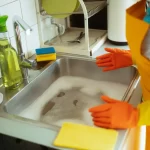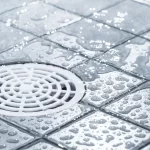A sudden downpour can quickly turn a dry basement into a soggy mess. For many Toronto homeowners, a sump pump basement system is the first line of defence against costly flooding and water damage. Whether you’re dealing with a damp crawl space or a finished basement, understanding how a sump pump works, how to install and maintain it, and also help you save for costly repairs.
Installing a basement sump pump isn’t just a smart precaution. It’s a key part of protecting your home from rising water tables, heavy rain, and drainage problems that are common throughout the Greater Toronto Area. A well-planned sump pump system keeps excess water away from your home and also reduce the the possibility of structural damage, mould growth, and ruined belongings.
In this blog, we’ll walk you through everything you need to know about sump pump installation. We’ll go over the fundamentals of how a sump pump operates, the various kinds that are available, where to install one, how to do it, and how to keep your system operating well over time. Costs, battery backup choices, and the importance of expert installation by a reputable business like Absolute Draining & Plumbing will also be covered.
Contact us today for expert sump pump installation and waterproofing services in Toronto, Etobicoke, Mississauga, and throughout the GTA.
What Is a Sump Pump and Why Your Basement Needs One

A sump pump is a powered drainage system designed to move water away from your basement or crawl space. The pump is located at the lowest area of your basement floor, which is known as a sump pit or sump basin. When water collects in the pit, either from heavy rain, melting snow, or a high water table, a float switch triggers the pump to turn on. After that, the pump forces water out of your house through a discharge line and away from the foundation.
Here’s why installing a sump pump in the basement matters:
- Prevent Flooding and Water Damage: During storms, a dependable primary pump prevents water from leaking into your basement.
- Protect Your Foundation: Continuous exposure to excess water can crack or weaken your foundation over time.
- Reduce Mould and Mildew: Keeping the basement dry lowers humidity, preventing mould growth and improving air quality.
- Maintain Home Value: Both buyers and insurers find homes with a professionally built sump pump system more appealing.
Types of Sump Pumps

Not all sump pumps are built the same. Choosing the right type of sump pump for your home will depend on your basement layout, water issues, and budget. Here are the most common options.
1. Submersible Sump Pump
A submersible pump sits entirely inside the sump basin, submerged in water, where it automatically activates as the water level rises. Its cast iron construction makes it stable and efficient for moving large volumes of water away from the home, helping with basement waterproofing and preventing water intrusion or basement flooding. This type of sump pump operates quietly, saves space, and is an excellent choice for finished basements where noise and aesthetics matter.
2. Pedestal Sump Pump
With a long shaft that reaches down to the water, the motor of a pedestal sump pump is situated above the sump pit. This design makes it easier to service and usually comes with a lower sump pump cost and reduced installation costs compared to submersible models. While effective for managing water in the basement, pedestal pumps may be noisier and, if the sump pump fails, there is an increased risk of flooding. They are best suited for smaller pits or unfinished basements where accessibility and affordability are top priorities.
Combination Sump Pump
A combination sump pump merges a primary pump with a backup pump system, providing extra security in case of a power outage or if the main unit stops working. This type of sump system is ideal for a sump pump basement in flood-prone areas or homes facing frequent storms. Many modern models feature advanced control systems for monitoring performance, making it easier to manage rising water. Homeowners often appreciate the relatively easy installation of a new pump and the added peace of mind knowing their property is protected. Just like other treatment systems designed to move water efficiently, a combination unit ensures reliable basement protection even under extreme conditions.
Key Components of a Sump Pump System

The pump alone is not the only component of a dependable sump pump system. Maintaining and troubleshooting your equipment is made easier when you understand each component.
- Sump Basin (or Pit): The hole dug into your basement floor where water collects.
- Float Switch: The pump is turned on when the water level hits a predetermined level.
- Discharge Line/Pipe: Water is transported away from your home’s drainage system by the discharge line or pipe.
- Check Valve: This stops water from returning to the sump pit.
- Battery Backup System: Keeps the pump running during power failures.
Where to Install a Basement Sump Pump
Proper placement is critical for an effective sump pump installation. The pump should be installed at the lowest point of the basement or crawl space where water naturally flows. Look for signs of past water pooling, such as stains on the concrete or damp corners. The chosen location should also be near.
- A GFCI outlet for power
- An exterior wall for easier discharge piping
- Adequate space for the sump basin and maintenance access
If your basement floor is concrete, a professional plumber will need to cut through the slab to create the pit and install the basin.
The Sump Pump Installation Process

While some handy homeowners attempt a DIY installation, most sump pump replacements and new installs are best left to professionals. A Toronto plumbing expert like Absolute Draining & Plumbing ensures proper sizing, safe electrical connections, and compliance with local codes. Here’s an overview of the professional installation steps:
- Assessment and Planning. The plumber inspects your basement to identify the best location and determines the right pump size for your water table and drainage needs.
- Digging the Sump Pit. A hole is cut into the basement floor and dug deep enough to hold the sump basin. Gravel is added to the bottom for stability and drainage.
- Installing the Basin and Pump. The basin is set into the pit and levelled. The submersible sump pump or pedestal pump is then placed inside.
- Connecting the Discharge Line. PVC piping is run from the pump to the outside of the house, ensuring water is discharged far enough away to prevent it from returning.
- Sealing and Testing. The pit is covered with a tight-fitting lid to reduce moisture and odours. The system is then tested to confirm the float switch, check valve, and discharge line are functioning properly.
Keep your home safe and dry year-round. Reach out to our professional plumbers serving Toronto, Etobicoke, and Mississauga for expert sump pump installation and maintenance.
Cost of Sump Pump Installation in Toronto
Consequently, the type of pump, basin size, and labor needs are some of the variables that affect sump pump installation costs. Homeowners in Toronto should budget between $1,200 and $3,000 on average for expert installation, which includes labour and materials. Other expenses could consist of:
- Battery backup system: $300–$800
- Backup sump pump: $400–$1,000
- Discharge pipe extension: $100–$300
While this might seem like a significant investment, it’s far less expensive than the repair costs of a flooded basement, which can easily exceed $10,000.
Sump Pump Maintenance Tips
To maintain your sump pump system operating at its best, routine maintenance is essential. A properly maintained pump can endure for at least seven to ten years. To maintain the smooth operation of your system, adhere to the following steps:
- Test the Pump Quarterly. Pour a bucket of water into the pit to make sure the float switch activates and the pump discharges water properly.
- Clean the Sump Pit. Remove debris, dirt, and gravel that could clog the pump.
- Inspect the Check Valve and Discharge Line. Check for leaks, cracks, or blockages that could prevent water from moving away from your home.
- Replace the Battery Backup. Batteries typically last 3-5 years. Test annually and replace as needed.
- Schedule Professional Inspections. Have a licensed plumber inspect your system once a year to catch potential issues early.
Common Sump Pump Problems and Solutions
Even the best sump pump can run into problems if not maintained. Here are some common issues and what to do about them:
- Pump Fails to Start. Check for a tripped breaker or power outage. If the motor is burnt out, a replacement may be needed.
- Pump Runs Continuously. A stuck float switch or a high water table could be to blame. Inspect and clean the float or call a plumber.
- Discharge Line Frozen or Blocked. Ensure the pipe is clear of ice or debris to allow proper drainage.
- Strange Noises. Grinding or rattling sounds may indicate a worn-out motor or impeller.
Battery Backup: Your Extra Layer of Protection
Power outages during Toronto storms might leave your basement susceptible in the event that your main sump pump fails. When the primary pump fails or there is a blackout, a battery backup sump pump keeps water out, offering vital safety.
Among the main advantages of a battery backup system are:
- Automatic activation during a power failure
- Extra pumping capacity during heavy rain
- Comfort in knowing that your basement remains dry and safe
Why Professional Installation Matters

Although installing a sump pump system might seem simple, doing it incorrectly might result in expensive malfunctions. That’s why professional installation matters because expert plumbers make sure to adhere to the following: (1) correct pit depth and basin sizing, (2) the discharge line’s proper slope for effective water removal, (3) safe GFCI outlets and secure electrical connections, and (4) compliance with Toronto building codes and drainage requirements.
Absolute Draining & Plumbing has been providing professional sump pump installation, replacement, and maintenance to households in the Greater Toronto Area for over 20 years. Their licensed team provides flat-rate pricing, detailed inspections, and a 25-year warranty on drain repairs, giving you confidence that your home is protected.
Need expert help with your basement sump pump installation? Contact our reliable plumbers in Toronto, Etobicoke, or Mississauga today for professional service.
Keep Your Basement Dry and Your Home Safe
Installing a sump pump basement provides reliable protection against floods and the problems brought on by excessive water. The strength of your foundation and the dryness of your home depend on every stage of the process, from selecting the best pedestal pump or submersible sump pump to scheduling regular maintenance.
Now is the moment to take action if you’re having problems with your water supply, you’re seeing high humidity, or you just want to safeguard your house before the next severe downpour. For a trustworthy sump pump installation and professional assessment, contact Absolute Draining & Plumbing. Our knowledgeable and expert staff will walk you through the procedure, guaranteeing that your investment is safeguarded for many years to come and that your basement remains dry.






